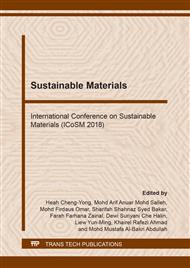[1]
R.F. Joel: Polymer Science and Technology. Prentice Hall. (2003).
Google Scholar
[2]
J. Biswal, V. Kumarn, Y.K. Bhardwaj, N.K. Goel, K. Dubey, C.V. Chaudhari and S. Sabharwal: Radiat. Phys. Chem. Vol. 76, (2007), pp.1624-1630.
Google Scholar
[3]
Y. Hong, S. Hwang, D.S. Yoo and J. Yang: Sens. Actuators. B Chem. 218 (2015) 31-36.
Google Scholar
[4]
R. Shamagsumova, A. Porfireva, V. Stepanova, Y. Osin, G. Evtugyn and T. Hianik: Sens. Actuators. B Chem. Vol. 220 (2015), pp.573-582.
DOI: 10.1016/j.snb.2015.05.076
Google Scholar
[5]
C. Yang and D. Li: Mater. Lett. Vol. 155 (2015), pp.78-81.
Google Scholar
[6]
R. Karthik and S. Meenakshi: Int. J. Biol. Macromol. Vol. 67 (2014), pp.210-219.
Google Scholar
[7]
E. Igberase, P. Osifo and A. Ofomaja: J. Environ. Chem. Eng. Vol. 21 (2014), pp.362-369.
Google Scholar
[8]
E. Pereira, A.L. Antonio, A. Rafalski, J.C.M. Barreira, L. Barros and M.B.P.P. Oliveira: LWT-Food. Sci. Technol. Vol. 82 (2017), pp.386-395.
Google Scholar
[9]
J. Lu, D. Wei, R. Wang, X. Sui and J. Yin: Vacuum Vol. 143 (2017), pp.283-287.
Google Scholar
[10]
F. Dong, S. Maganty, S.J. Meschter, S. Nozaki, T. Ohshima, T. Makino and J. Cho: Polym. Degrad. Stabil. Vol. 141 (2017), pp.45-53.
Google Scholar
[11]
P. Xue, Y. Zhao, C. Wen, S. Cheng and S. Lin: Food Chem. Vol. 233 (2017), pp.467-475.
Google Scholar
[12]
M.M. Nasef, S.A. Gürsel, D. Karabelli and O. Güven: Prog. Polym. Sci. Vol. 63 (2016), pp.1-41.
Google Scholar
[13]
A. Athawale, M.V. Kulkarni and V.V. Chabukswar: Mater. Chem. Phys. Vol. 73 (2002), pp.106-110.
Google Scholar
[14]
E. Coşkun, .SM. Martínez-Ramírez, W. Antunez-Flores, C.A. Hernández-Escobar and E.A. Zaragoza-Contreras: Synthetic. Met. Vol. 162 (2012), pp.344-351.
DOI: 10.1016/j.synthmet.2011.12.016
Google Scholar
[15]
A. Tiwari and V. Singh: Carbohyd. Polym. Vol. 74 (2008), pp.427-434.
Google Scholar
[16]
M. Barsbay and O. Gven: Polym-United Kingdom, Vol. 54 (2013), pp.4838-4848.
Google Scholar
[17]
S. Bhadra and D. Khastgir: Polym. Degrad. Stabil., Vol. 92 (2007), pp.1824-1832.
Google Scholar
[18]
S. Bhadra and D. Khastgir Polym. Degrad. Stabil. Vol. 93 (2008), pp.1094-1099.
Google Scholar
[19]
M.B. El-Arnaouty, A.M. Abdel Ghaffar and H.M. El Shafey: J. Appl. Polym. Sci. Vol. 107 (2008), pp.744-754.
DOI: 10.1002/app.27099
Google Scholar
[20]
D.K. Mandal, H. Bhunia, P.K. Bajpai, C.V. Chaudhari, K.A. Dubey and L. Varshney: Radiat. Phys. Chem. Vol. 123 (2016), pp.37-45.
Google Scholar
[21]
C.H. Chen: J. Appl. Polym. Sci. Vol. 89 (2003), pp.2142-2148.
Google Scholar
[22]
S. Pandey and J. Ramontja: Int. J. Biol. Macromol. Vol. 89 (2016), pp.89-98.
Google Scholar
[23]
M. Takigami, A. Hiroki, N. Nagasawa, T. Kasahara, S. Takigami. and M. Tamada : Trans. Mat. Res. Soc. Vol. 34 (2009), p.391–394.
DOI: 10.14723/tmrsj.34.391
Google Scholar
[24]
R.Bagheri, F. Naimian and N. Sheikh: Radiat. Phys. Chem. Vol. 49 (1997), pp.497-501.
Google Scholar
[25]
S. Benamer, M. Mahlous, D. Tahtat, A. Nacer-Khodja, M. Arabi, H. Lounici and N. Mameri: Radiat. Phys. Chem. Vol. 80 (2011), pp.1391-1397.
DOI: 10.1016/j.radphyschem.2011.06.013
Google Scholar
[26]
G.R. Bardajee, A. Pourjavadi, N. Sheikh and M.S. Amini-Fazla Radiat. Phys. Chem. Vol. 77 (2008), pp.131-137.
Google Scholar
[27]
J.L. Garnett: Radiat. Phys. Chem. Vol. 14 (1977), pp.79-99.
Google Scholar


